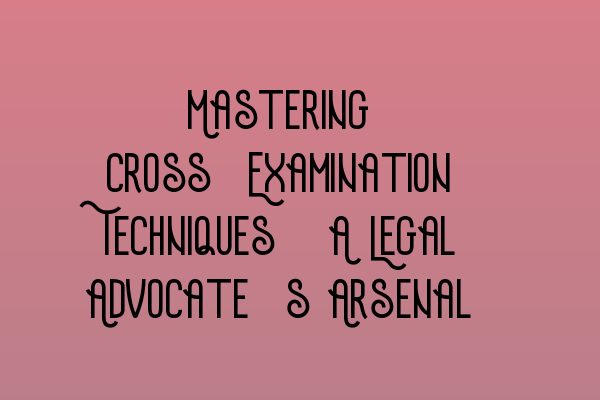Mastering Cross-Examination Techniques: A Legal Advocate’s Arsenal
As a legal advocate, mastering the art of cross-examination is crucial for building a strong and persuasive case. Cross-examination allows you to challenge, discredit, and expose inconsistencies in the testimony of witnesses presented by the opposing party. It is a powerful tool that can greatly influence the outcome of a trial. In this article, we will explore some essential cross-examination techniques that every legal advocate should have in their arsenal.
The Power of Effective Cross-Examination
Effective cross-examination can enable you to:
- Undermine the credibility of the witness
- Expose contradictory statements or inconsistencies
- Draw out favorable evidence for your case
- Create doubt in the minds of the jurors
By strategically employing these techniques, you can effectively challenge the credibility and reliability of the opposing party’s witnesses, weakening their case and strengthening your own.
Key Techniques for Mastering Cross-Examination
1. Leading Questions
One of the most powerful tools in cross-examination is the use of leading questions. These are questions that suggest the desired answer or control the witness’s response. By asking leading questions, you can steer the witness towards the answers that support your case while limiting their ability to provide damaging testimony.
2. Control and Confidence
Confidence is key when conducting cross-examination. Maintain control of the witness and the courtroom through a confident and assertive demeanor. Maintain eye contact, project your voice, and be well-prepared with your line of questioning. This will help you establish credibility and command the attention of the jury.
3. Impeachment
Impeaching the witness’s credibility is a critical aspect of cross-examination. Look out for opportunities to challenge the witness’s truthfulness, bias, or faulty memory. Use prior inconsistent statements, prior convictions, or any other relevant evidence to cast doubt on the witness’s reliability. By impeaching the witness, you can weaken their testimony and strengthen your own case.
4. Controlling the Narrative
Use cross-examination to control the narrative of the case. Through skillful questioning, you can shape the way the jury perceives the facts and events. Highlight favorable evidence, emphasize key points, and downplay damaging testimony. By controlling the narrative, you can influence the jury’s understanding of the case in your favor.
Continuing Legal Education for Mastery
Mastering cross-examination techniques requires continuous practice, refinement, and staying updated with the latest legal strategies and developments. Participating in SQE 1 and SQE 2 preparation courses can provide valuable insights and training to strengthen your cross-examination skills and overall legal advocacy.
Ensure you stay up-to-date with essential legal knowledge and take advantage of resources such as the SQE 1 Practice Exam Questions and the SQE 1 Practice Mocks FLK1 FLK2. These resources can help improve your understanding of legal principles and enhance your ability to apply cross-examination techniques effectively.
Furthermore, consider enrolling in comprehensive SQE 2 Preparation Courses and SQE 1 Preparation Courses to enhance your overall legal knowledge and skills required for effective cross-examination.
Conclusion
Mastering cross-examination techniques is the key to becoming an exceptional legal advocate. By skillfully executing leading questions, maintaining control and confidence, impeaching witness credibility, and controlling the narrative of the case, you can significantly influence the outcome of a trial.
Remember to continually invest in your professional development through continuing legal education courses, such as the ones offered by SQE Criminal Law & Practice Law UK. Stay up-to-date with the latest legal strategies and take advantage of resources like SRA SQE Exam Dates to ensure you are well-prepared to present a compelling case using your cross-examination skills.
